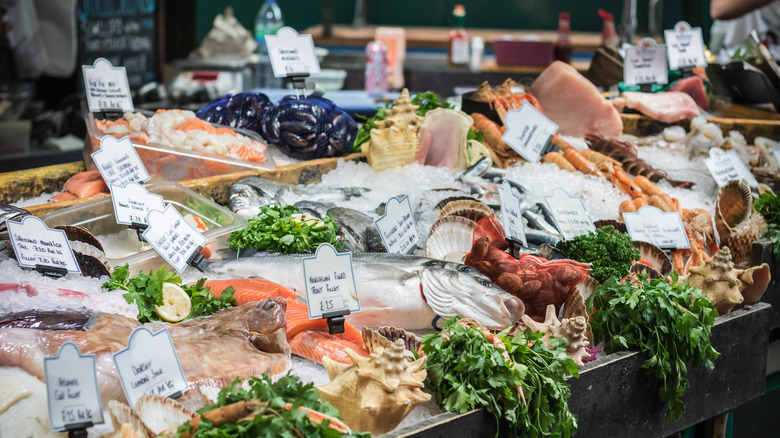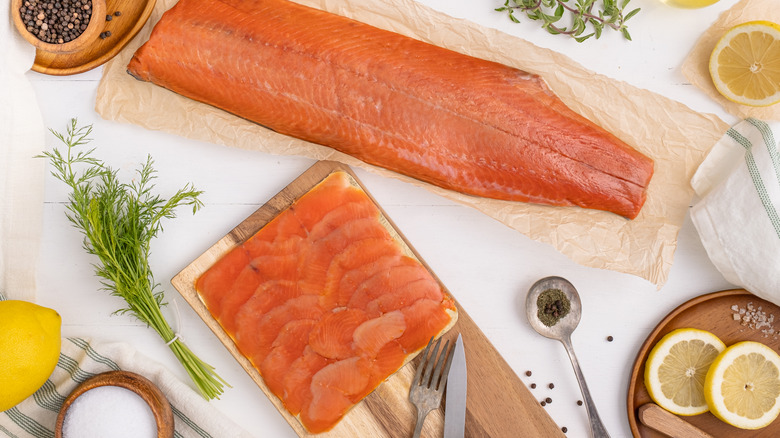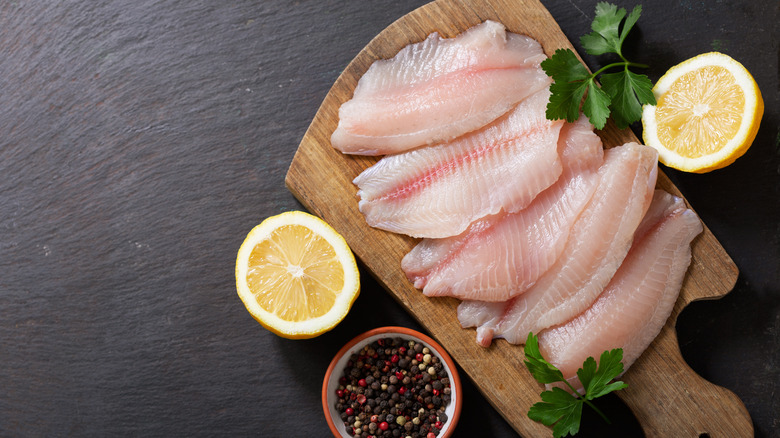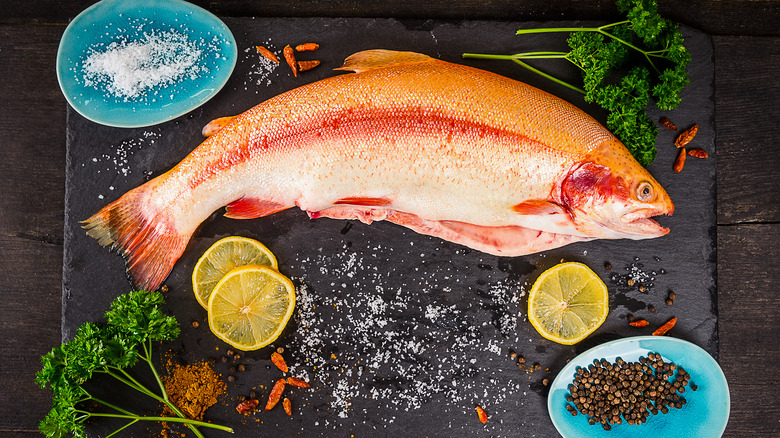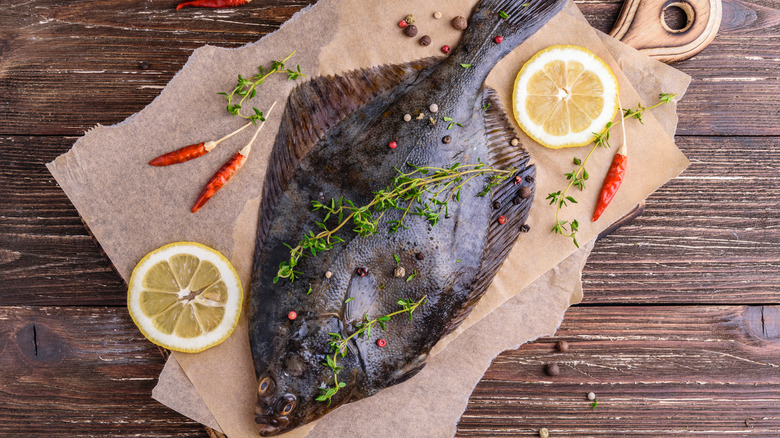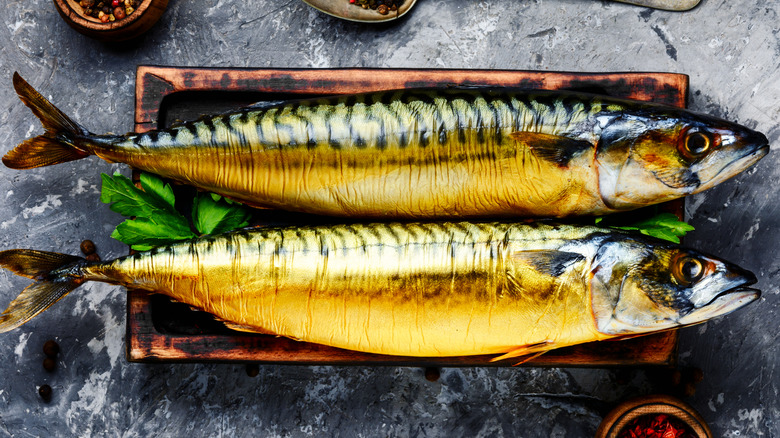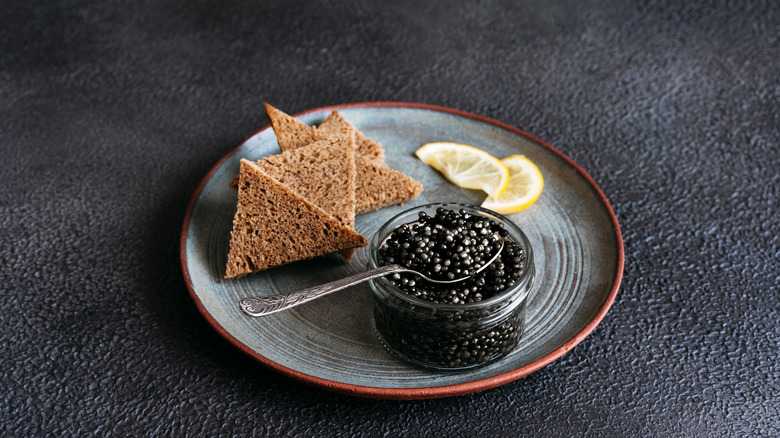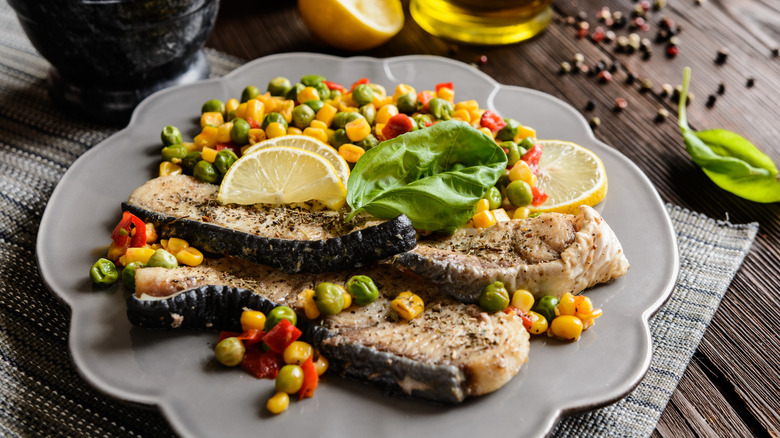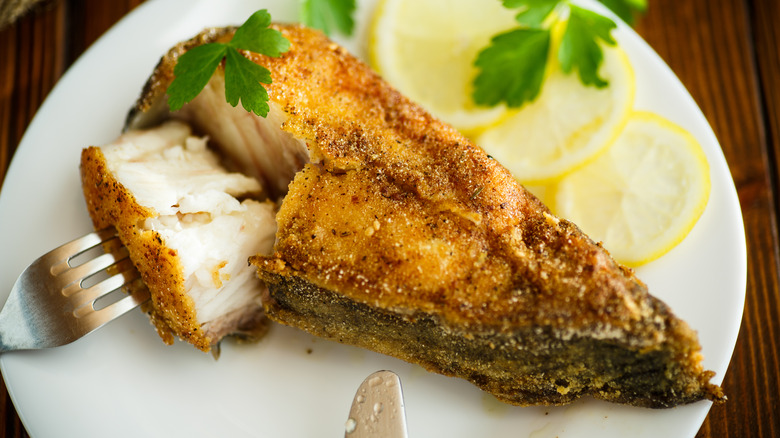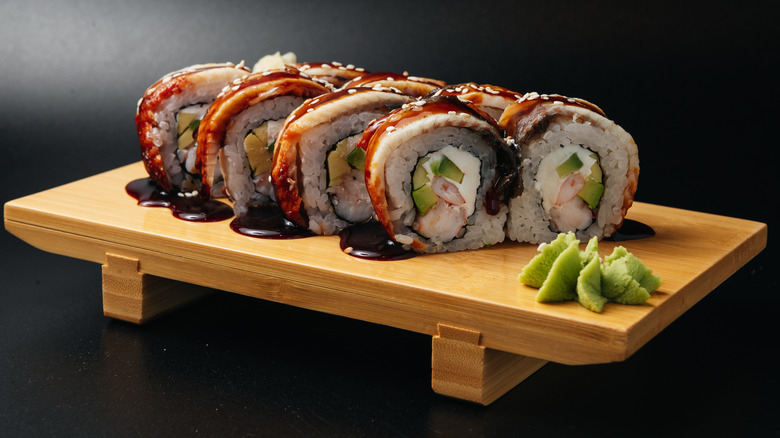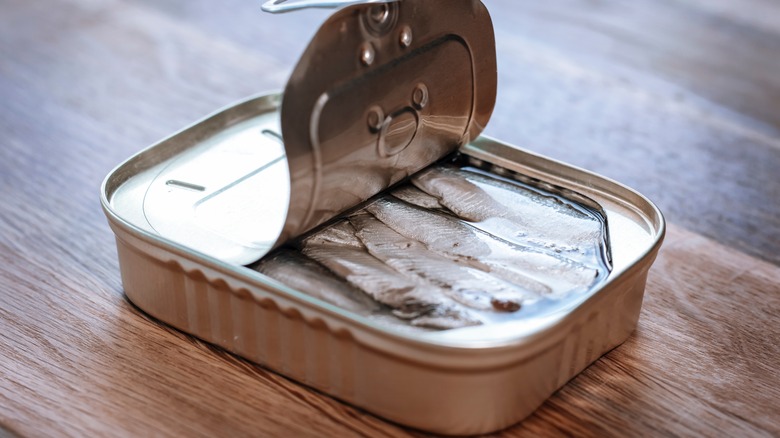7 Types Of Fish You Should Be Eating More Of And 7 To Avoid
The conventional wisdom surrounding fish consumption is fuzzy, to say the least. Some people denounce eating fish altogether while others claim it is the healthiest protein you can put in your body. And then there are varying opinions that lie somewhere between the two opposite schools of thought. It's no wonder many are confused!
Nevertheless, choosing to avoid or consume fish is not a black-and-white situation. Some of the healthiest fish for your body may have environmental implications (via Medical News Today). At the same time, some of the most sustainably-harvested swimmers can wreak havoc on your insides when consumed in excess and occasionally even when consumed in moderation (via Healthline).
Taking both the environmental impact and your health into consideration may seem like a daunting task. After all, how do you split the difference between the two while also enjoying your coveted sushi date nights? Here's some vital information to get you started.
Avoid: Farmed salmon
At first, it might not seem like there are huge differences between consuming farmed salmon versus fresh, wild-caught salmon. Unfortunately, the dichotomy is steep, and experts recommend avoiding farmed salmon for the most part. Farmed salmon are traditionally raised in aquaculture environments. They are fed a totally different diet than wild salmon, and nutritionally, it can make a huge difference.
As outlined by Healthline, farmed salmon has three times as much fat per 4-ounce serving when compared to wild-caught salmon. This happens because farmed salmon are fed high-fat diets to ensure they reach larger sizes. To make matters worse, much of that fat comes from omega-6 fatty acids, the kind that we want to consume only in moderation.
Farmed salmon tend to have higher levels of contaminants, but certain groups are trying to enforce stricter rules on feeding, which might help decrease these contaminants. Since farmed salmon live in close quarters and are more likely to become sick, many farmed salmon are given antibiotics to prevent illnesses. The antibiotics used in the salmon feed can trickle into your body through consumption and can lead to antibiotic resistance and other issues. Norway and Canada are two of the cleanest producers of farmed salmon. Farmed salmon from Chile, however, has been shown to have the biggest issue with excessive antibiotic use as of 2018 (per Healthline).
Eat: Wild-caught Alaskan salmon
You might think it sounds bougie to only want to eat wild-caught Alaskan salmon but from the perspectives of health and environmentalism, seeking out this kind of salmon is the better choice. Not only does wild-caught salmon have a third of the amount of fat that farmed salmon has, but it also contains more essential minerals and nutrients, including iron and calcium. Some studies have shown that wild-caught salmon has a healthier omega-3 to omega-6 ratio as well. This is partially due to the lesser amount of fat in the flesh of wild-caught salmon (per Healthline).
Alaskan salmon, specifically, are sustainably sourced and certified by the Monterey Bay Aquarium Seafood Watch program. This sits in stark contrast to the disruption that salmon farms can have on the flora and fauna of the ocean, a major concern of the Worldwide Wildlife Fund. Alaskan salmon is also certified by the Marine Stewardship Council, the non-profit agency that essentially gives out gold stars to those who enact sustainable fishing practices.
If your main concern about eating fish is the environmental implications, look for the MSC blue fish label. The label will make it easy for you to identify which seafood is sustainably sourced and which should be avoided because of the destruction that harvesting could have on delicate marine ecosystems.
Avoid: Tilapia
"Tilapia" is an umbrella term for a whole collection of freshwater fish within the cichlid family (per Healthline). At least 135 countries farm and harvest tilapia because it makes an exceptional product — people love it, they grow fast even in cramped quarters, and they exist on a cheap diet. However, the dangers that this type of fish can cause vary greatly based on the country in which it is raised.
Compared to other widely-consumed fish, tilapia is seriously lacking in nutrition, mostly because it has a much higher fat content than other fish. Specifically, it contains far fewer omega-3 fatty acids — which can help control cholesterol and heart disease and lead to a more youthful appearance — and more omega-6 fatty acids than its healthier counterparts. Omega-6s can contribute to inflammation within the body, leading to further illnesses and diseases down the road. In fact, according to Healthline, tilapia contains the highest omega-3 to omega-6 ratio of all fish.
Because the demand for flaky, less-fishy-flavored tilapia is so high, fisheries in China have been observed using livestock feces to feed their fish. Additionally, unsafe chemicals may be used. Experts agree that avoiding farmed tilapia from China is the way to go. If don't want to give up tilapia, opt for wild-caught if at all possible or farmed from the United States, Canada, the Netherlands, Ecuador, or Peru (per Healthline).
Eat: Rainbow trout
If the words "rainbow trout" conjure up childhood images of your grandparents' weirdly-breaded but somehow also soggy dinnertime favorite, you are not alone. But change it's time to change that perspective because rainbow trout is actually healthy and sustainable seafood. Interestingly, the Monterey Bay Aquarium asserts that the very best rainbow, or steelhead, trout comes from Lake Superior in Minnesota. The more you know.
Health-wise, rainbow trout weighs in just behind salmon when it comes to omega-3 content. Eating a serving of rainbow trout will also provide you with selenium, vitamin B12, vitamin B6, and a bunch of potassium — and that's in addition to its high protein content (via Eating Well).
The Global Seafood Alliance has strict protocols when it comes to recirculating agricultural systems (RAS), or fish farming. Rainbow trout is fairly inexpensive to farm. Because so much research has been done, biosecurity in this type of fish is top-notch. One of the main things the alliance looks for is a comprehensive list of pathogens that might contaminate the fish. Because rainbow trout and the farms in which they thrive have been placed under examination, they can operate with an eye for sustainability while they pump out clean, healthy fish for consumption.
Avoid: Atlantic flatfish
The encompassing phrase "Atlantic flatfish" includes sole, flounder, and halibut caught off of the Atlantic coast. Avoiding east coast flatfish will benefit both your health and the environment. Though much of the overfishing in this part of the world began in the 1800s, even the decades of effort put in to repopulate have not yet fully replenished the amount of flatfish in this region. There still aren't enough of the little guys to consider them repopulated (via Prevention). This is, in part, due to how long it takes them to mature. Some species of Atlantic flatfish take up to 50 years to mature, according to Global Seafoods, which is part of why it has been so challenging to replenish their populations.
Beyond just the environmental impact, much of the Atlantic flatfish that is caught today has proved to be riddled with contaminants. As recently as the 1980s, around 75% of the fish caught in Boston showed signs of liver disease and cancerous tissues. Generally speaking, the older the fish, the more heavy metals they contain, and since flatfish take years to fully mature, they absorb more mercury than many other of our fancy restaurant favorites (via Global Seafoods).
Eat: Atlantic mackerel
Just because you should take Atlantic flatfish out of the equation doesn't mean your days of enjoying fresh fish in Cape Cod are over. Enter Atlantic mackerel, a healthy and eco-friendly choice for those days when fresh fishy-tasting fish is calling your name. Though not all mackerel is created equal, Atlantic mackerel, specifically. is one species of fish lowest in mercury. This does not apply to Spanish or King mackerel, located on the "high" and "highest" list for mercury, respectively. Atlantic mackerel contains around 0.05 parts per million (ppm) of mercury, allowing it to rest directly behind sardines, the least mercury-containing fish for consumption (via Nutrition Advance).
Atlantic mackerel is a species that is quick to grow and replenish its population. Because of this, they can handle more fishing than species that take longer to mature. The gear used to catch mackerel is less invasive and harmful to the environment, which helps keep the proliferation and consumption of these fish sustainable (per Eating Well).
A 3-ounce portion of Atlantic mackerel contains around 20 grams of lean protein with a hearty dose of healthy omega-3 fatty acids on the side, according to Eating Well. The same serving will deliver nearly 300% of the daily recommended amount of vitamin B12.
Avoid: Caviar
Caviar has a strange reputation. On the one hand, you may have heard that eating caviar as it graces every single one of the appetizers at a soirée is glamorous. On the other hand, you might be seeing red retroactively after learning that fishermen used to harvest fish to "cut out their 'roe sacs' ... and throw the fish back in to die," as The Guardian reported. No matter which camp you belong to, it's time to set the record straight. Even the most "ethically sourced" caviar comes with a side of ethical woes.
Caviar is the unfertilized eggs, or roe, from a sturgeon fish. But the eggs don't just come tumbling out of these bad boys like they do chickens. On the gentle end of the spectrum, an incision needs to be made to harvest the caviar, and the eggs need to be massaged out. On the more aggressive end, the fish do not get to undergo major surgery but instead meet their demise for their eggs. Some fisheries will harvest the meat of the fish and the eggs at the end of the fishes' lives — making these the most ethical caviar harvesting operations.
Because so many regulations have been enacted to prevent the extinction of these prehistoric fish, many nefarious people have opted to sell caviar on the black market, according to National Geographic. While caviar is a nutritional powerhouse, according to Healthline, it is still something you should cut back on eating.
Eat: Herring
If your frame of reference for herring is solely pickled herring, you may be discounting the benefits of this protein-and-vitamin-packed fish. A standard 3-ounce serving of herring contains vitamin D, selenium(a trace mineral that aids in fertility and cognitive function), and about 20 grams of lean protein. Because herring is known to have less mercury than other popular fish, WebMD recommends herring as a healthy fish for pregnant women to consume. Omega-3 fatty acids have been proven to help in fetal brain development and decrease heart-related complications in non-pregnant adults.
Since herring is a small and rapidly-populating fish that is at the lower end of the food chain, it is a sustainable choice to eat whether it is wild-caught or farmed. Because the larger fish are often hunted as food sources, this leaves their prey wide open to reproduce, which leads to more little fish. Herring is a healthy and sustainable seafood choice that we should all be eating a bit more of (via The Guardian).
Avoid: Shark
While logically it makes sense to eat an animal before it eats you, this is not so with sharks. In some cultures, shark meat is seen as a medicinal food. In others, it is considered a delicacy in the world of seafood, and in other cultures still, it is eaten simply because that is what is available. But the health consequences of eating shark meat are too dangerous to risk eating, period.
Since sharks are apex predators, they eat whatever crosses their paths, whether it be a large, heavy-metal-riddled fish to plastic. This no-holds-bar-at-the-buffet attitude allows sharks to accumulate a ton of toxins, including mercury, arsenic, and lead (via Independent). In case the fact that shark meat is full of toxins does not convince you to steer clear of it as a protein source, perhaps the knowledge that shark-harvesting is environmentally disruptive will.
Each year, around 100 million sharks are killed by the fishing industry, according to National Geographic. "Such dramatic population plunges are not only dangerous for sharks but also for entire ecosystems," explained Smithsonian. "When shark populations decrease, a ripple effect can spread throughout the rest of the ecosystem."
Eat: Sablefish
Sablefish, aka black cod, is not actually a type of cod at all. It is a nutritious and delectably oily fish with a ton of health benefits and sustainable sourcing to boot. "U.S. wild-caught sablefish is a smart seafood choice because it is sustainably managed and responsibly harvested under U.S. regulations," according to the National Oceanic and Atmospheric Administration (NOAA).
The sablefish populations of Alaska are thriving, and the Pacific Coast populations are at their target populations. The rate at which they are fished is aiding in their population growth, and how they are fished causes minimal harm to the natural habitats. In fact, the Environmental Defense Fund voted Alaskan sablefish as one of the best choices for individual health and the environment.
Sablefish is naturally oily, typically containing more omega-3s than other, less oily fish. One serving contains roughly 1,000 milligrams of omega-3 fatty acids (via Seafood Nutrition Partnership). According to Healthline, the recommended minimum intake of omega-3s for an adult per day is around 250 milligrams, and the upper limit has yet to be fully defined. That said, let's eat up in the name of health!
Avoid: Orange roughy
Though the name "orange roughy" is the cutest ever, the effects of actually eating this kind of fish are not the cutest. In fact, the amount of mercury that is often present in orange roughy can accumulate in your system if you eat it too often (via SF Gate).
Mercury accumulation within your body can lead to neurological dysfunction, and even moderate consumption of mercury-containing fish can be harmful for pregnant women to ingest. According to the College of Family Physicians of Canada, a fetus's brain is incredibly susceptible to atypical development, and mercury has been proven to increase the risk of cerebral palsy and other neurological disorders. Furthermore, SF Gate recommends that children limit their intake of orange roughy because of how harmful the accumulation of mercury can be.
All heavy metal concerns aside, orange roughy is a lean, protein-packed fish that might lead you to believe that you can skate by and enjoy it once in a while. However, it has been ranked as one of the worst fish to eat regarding environmental concerns (via SF Gate). This is due to orange roughy being overfished. If you're in the mood for orange fish, opt for the salmon instead of the orange roughy to benefit your brain and the world.
Eat: Catfish
Catfish are not the prettiest fish, but don't let their countenance fool you. Beyond just the nutritional benefits of eating a serving of catfish, this fish tends to absorb fewer contaminants and heavy metals than longer-living and larger fish. Swordfish, for example, have been known to contain 40 times more mercury than catfish, according to the FDA.
A 3.5-ounce serving of catfish contains roughly 3 grams of fat, which is slightly higher than other types of healthy fish, but it is balanced with an impressive 18 grams of protein. It has a slightly less impressive omega-3 to omega-6 ratio. Still, the number of vitamins and minerals outweigh the slightly elevated amount of omega-6 fatty acids. One serving of catfish provides you with selenium, phosphorus, potassium, thiamine, and vitamin B12, all of which aid in overall health (per Healthline).
Environmentally speaking, blue catfish from the United States is your best bet. The Monterey Bay Aquarium's Seafood Watch lists catfish from China as a kind to avoid, and catfish from the Chesapeake Bay tops the list as the best all-around choice when it comes to catfish.
Avoid: Eel
Unfortunately for fans of unagi or anago, the health benefits of eel meat don't quite make up for its propensity to harbor toxins and the fact that the eel population has been in slow and steady decline over the past half-century.
The Monterey Bay Aquarium Seafood Watch explains that eel is on the list of seafood to avoid because of sustainability issues regarding eel harvesting. While many groups are hard at work trying to determine sustainable ways to breed eels for consumption, many species of eel are endangered and at risk of becoming extinct.
According to the Environmental Defense Fund, most types of eel fall within the "elevated" category when it comes to mercury levels. And while this is not often a huge problem, raw eel contains a compound that is toxic to mammals, including us as humans! This is why even the eel found in sushi is cooked (via Nutrition Advance).
Eat: Pacific wild-caught sardines
Though the idea of munching on sardines as a snack may not sound very appealing, Pacific wild-caught sardines are one of the best, if not the best, fish to consume for multiple reasons. And it turns out, you can actually make these itty-bitty fish taste pretty darn good if you know how to prepare them properly. We are talking about garlic, garlic, and more garlic.
Sardines are small and reproduce quickly, which has allowed them to recover from the devastating overfishing that occurred throughout the 1940s. Since they are small and have relatively short lifecycles, they do not have as much time to accumulate harmful heavy metals when compared to the fish equivalent of octogenarians.
Nutritionally, Pacific sardines are a powerhouse. They contain a plentiful amount of naturally-occurring vitamin D, a rare but splendid attribute. One serving contains over 1,000 milligrams of heart-healthy omega-3s in addition to a whopping amount of calcium (per Eating Well). When vitamin D and calcium are consumed at the same time, it results in an increased ability to absorb the available calcium. As is the case with many other great seafood choices, sardines contain selenium, phosphorus, niacin, iodine, and plenty of vitamin B12 (per WebMD).

